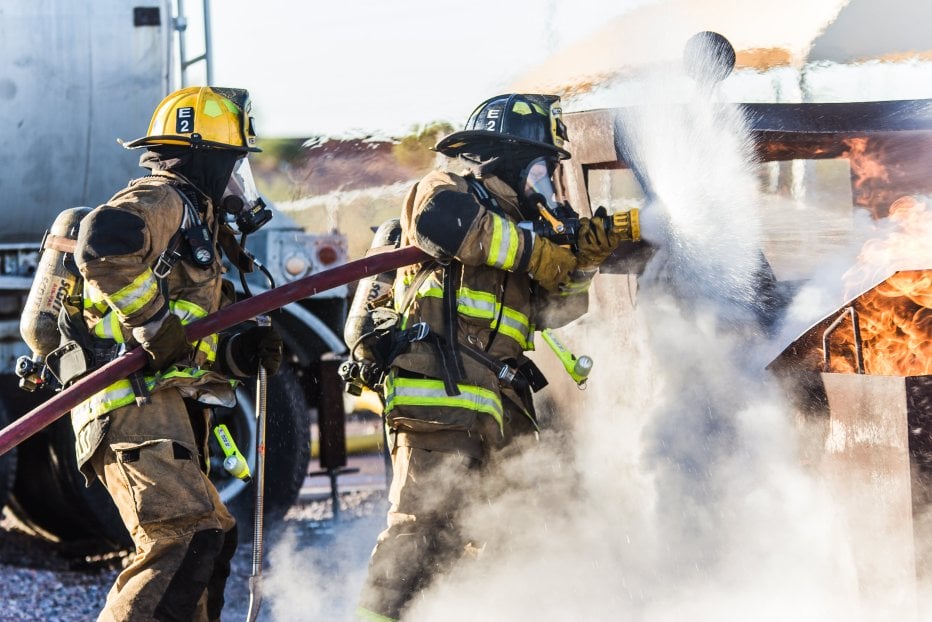The Benefit of Giant Sets To Firefighters

By: John Hofman, MS, CSCS
So many firefighters are pressed for time. Between Captain’s classes, training, house duties, and the occasional EMS/Fire call – time is always a limited resource. Yet exercise should still be made a priority. Staying in shape sometimes is as easy as 1-2-3.
There are so many ways to exercise in today’s world. Sometimes it becomes a little overbearing on deciding what the best method to exercise is. Some fitness experts believe a firefighter should perform a high intensity circuit while others believe long steady state aerobic training is the key. The best answer is determined by the firefighter and the specific goal they are trying to accomplish. For most firefighters, staying in good cardiovascular shape while at the same time maintaining their strength is important but trying to perform both can also be time consuming. A simple solution is to perform “Giant Sets.” Performing giant sets three times a week will help keep your heart rate up while you are training for strength, thus accomplishing two things at once. They are extremely effective at building muscle and burning fat.
The philosophy behind “Giant Sets” is to incorporate a push, pull, leg, and sometimes core and/or total body exercise where the firefighter is able to focus on strength, power, and fitness. How it differs from circuit training or the old fashion three sets of 10 reps is the following: most circuits are performed by moving from exercise to exercise focusing on a high amount of repetitions or time, and the primary goal is fitness (elevated heart rate). Giant sets also move from exercise to exercise but the load is much heavier allowing the firefighter to focus on their strength while at the same time keep the heart rate up. In regards to the “old fashion” way of lifting, Giants sets will not allow you to rest as long as your regular “3 sets of 10 reps” because you are moving to the next exercise.
The heart rate will remain elevated because of a few reasons :
1. You are using large muscle groups which require a lot of oxygen
2. The load is high so your heart will be pumping
3. When you perform a squat you are using your legs, therefore your back and chest are resting, then you proceed directly to pull-ups and here the back is working but the legs and chest are resting, but the heart rate is working in a continuous manner. It is basically an agonist /antagonist method to exercise.
The key is to know how to plan out your program so you can develop the correct phase. Studies have shown that the manipulation of training variables appears to have important implications on the physiological response to resistance exercise. For many firefighters, it is not only important to have a strong heart but also a reduction in body fat. It is not uncommon for a firefighter to gain weight over the years due to a reduction in hormonal production. Other studies have shown that hormonal responses to acute heavy resistance exercise are sensitive to changes with the manipulation of rest intervals, exercise intensity, and volume. Specifically, significantly higher testosterone concentrations have been observed when rest periods between sets are reduced (three to one min), or when the intensity of exercise is decreased (five Repetition Max [RM] to 10-RM) and volume is increased.
There are a variety of fitness levels in the fire service so it can be difficult to decide on the proper load for each person. For example, a truck crew may have four different levels of fitness so it could be a challenge to determine what load should be used to meet the demands of each firefighter. One easy method is to use the level of THAT FIREFIGHTER with each day having a focus based on the exercises selected.
Day one will be used as a heavy day incorporating large muscle groups that utilize heavy lifts such as squats, bench press, and pull-ups. The rep scheme would be based off a moderate load (4-6 reps), a pyramid (8-6-4-2-4-6-8), work up/work out set (10-8-6-4, 5×5) but the load will be determined by the individual firefighter as they move from one exercise to the next. Again understanding the inverse relationship between load and reps. As one increases the other will decrease.
Our second day of exercise would progress to a medium day, which will incorporate medium loads, but in addition to apply time-under-tension (TUT). By controlling the tempo (holds, pause, etc…) the firefighter can manipulate. They could pause/hold half way up and half way down on any movement as well as the top/bottom of the lift.
For example: a firefighter could perform 5 sets of 5 reps – 4 second hold (5×5-4). While lowering the bar, they pause and hold for 4 seconds, proceed to lower to their chest and hold for 4 seconds, return to the halfway point and again hold for 4 seconds, and finally complete the rep by pressing to the top. Again, understand as the reps decrease the hold time increases. (8×6 for 6 seconds). TUT will force the firefighter to control the load placed on the bar.
Finally, we approach our last day which will be a light day. As the week progresses our bodies breakdown, therefore we apply a light day towards the end of the week. Different implementations would be utilized here. Instead of a barbell curing the bench press we may use a medicine ball, or while performing pull-ups we will incorporate some tubing or bungees to accelerate our pull. The pattern of movements will be similar to the previous days but our training stimulus is different. Because we are working with a very light load, speed could be incorporated which can include a timer. Workouts should be no more than 20 seconds long with up to 60 seconds recovery.
WHY?
The focus of the workout is not fitness but rather quality of the work produced. The key is to see if the firefighter can recover during the rest time and have the same quality in each set. As you progress you can reduce the recovery time for shorter rest periods. It is important to develop a firefighters “fast-twitch” muscles which require short bursts with high force output. This type of training also responds to hypertrophy training much better than training slow twitch fibers.
Photo by Matt Chesin on Unsplash
Podcast
Contests & Promotions
















